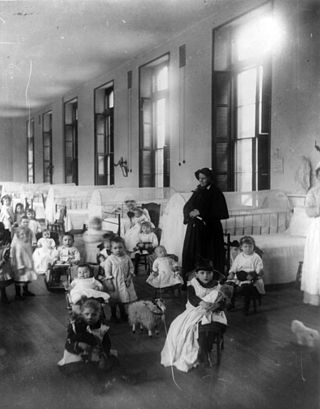Types
Adoptions in the United States may be either domestic or from another country. Domestic adoptions can be arranged either through a state agency, an adoption agency, or independently. [3]
By family members
In the United States, most adoptions involve a child being adopted by a person who is married to a birth parent, or by another existing relative. [4] Adoption by a stepmother or stepfather is called a stepparent adoption . If the child is adopted by a person who lives with, but is not married to, a birth parent, then it is called a second-parent adoption. [5] More broadly, these may be called known-child adoptions , which includes adoption by family members, family friends, or other people previously known to the child.
Generally, stepparent adoption requires consent from all living, legally recognized parents. [4] The process usually terminates the rights of the non-custodial parent. [4] The parent whose rights are terminated will no longer need to pay child support or have any other responsibilities for the adopted child. [4] In most, but not all US states, the child's right to inherit property after the death of the birth parent is also ended. [6] Older children are normally expected to give their consent as well.
Through the foster care system

The United States foster care system enables adults to care for minor children who are not able to live with their biological parents.
If a child in the U.S. governmental foster care system is not adopted or returned to the custody of their birth parents by the age of 18 years, they are aged out of the system on their 18th birthday. To help encourage the adoption of children presently in foster care, adoption exchanges were created, so the county adoption agencies around the country could have a central data base to help waiting children find homes. This allows prospective adoptive parents to not only see children waiting for adoption in their own region, but throughout the nation. [7] The central adoption exchange is adoptuskids.org, created through a grant of the Children's Bureau, U.S. Office of Administration of Children and Families. [8]
International adoption
Prospective American adoptive parents may use international adoption (also called intercountry adoption) to adopt a child from another country. American citizens, including American citizens who have emigrated from countries they wish to adopt from, represent the majority of international adoptive parents, followed by Europeans and those from other developed nations such as Australia.[ citation needed ] The laws of different countries vary in their willingness to allow international adoptions. Some countries, such as China, Korea and Vietnam, have very well established rules and procedures for foreign adopters to follow, while others, the United Arab Emirates (UAE) for example, expressly forbid it. International adoptions by Americans became much more common after the Korean War when American servicemen fathered interracial children with Korean women. China is the leading country for international adoptions by Americans.
The U.S. Department of State has designated the Intercountry Adoption Accreditation and Maintenance Entity, Inc. (IAAME), as the accrediting agency responsible for accreditation, approval, monitoring, and oversight of adoption service providers that provide intercountry adoption services in the United States. [9] The IAAME maintains a list of accredited international adoption service providers.
Adoption facilitators
There are also individuals who act on their own and attempt to match waiting children, both domestically and abroad, with prospective parents, and in foreign countries provide additional services such as translation and local transport. They are commonly referred to as facilitators. Since in many jurisdictions their legal status is uncertain (and in some U.S. states they are banned outright), they operate in a legal gray area.
Where the law does not specifically allow them to, all they can do is make an introduction, leaving the details of the placement to those legally qualified to do so. But in practice, their role as gatekeepers can give them a great deal of power to direct a particular child to a particular client, or not, and some have been accused of using this power to defraud prospective adoptive parents.


